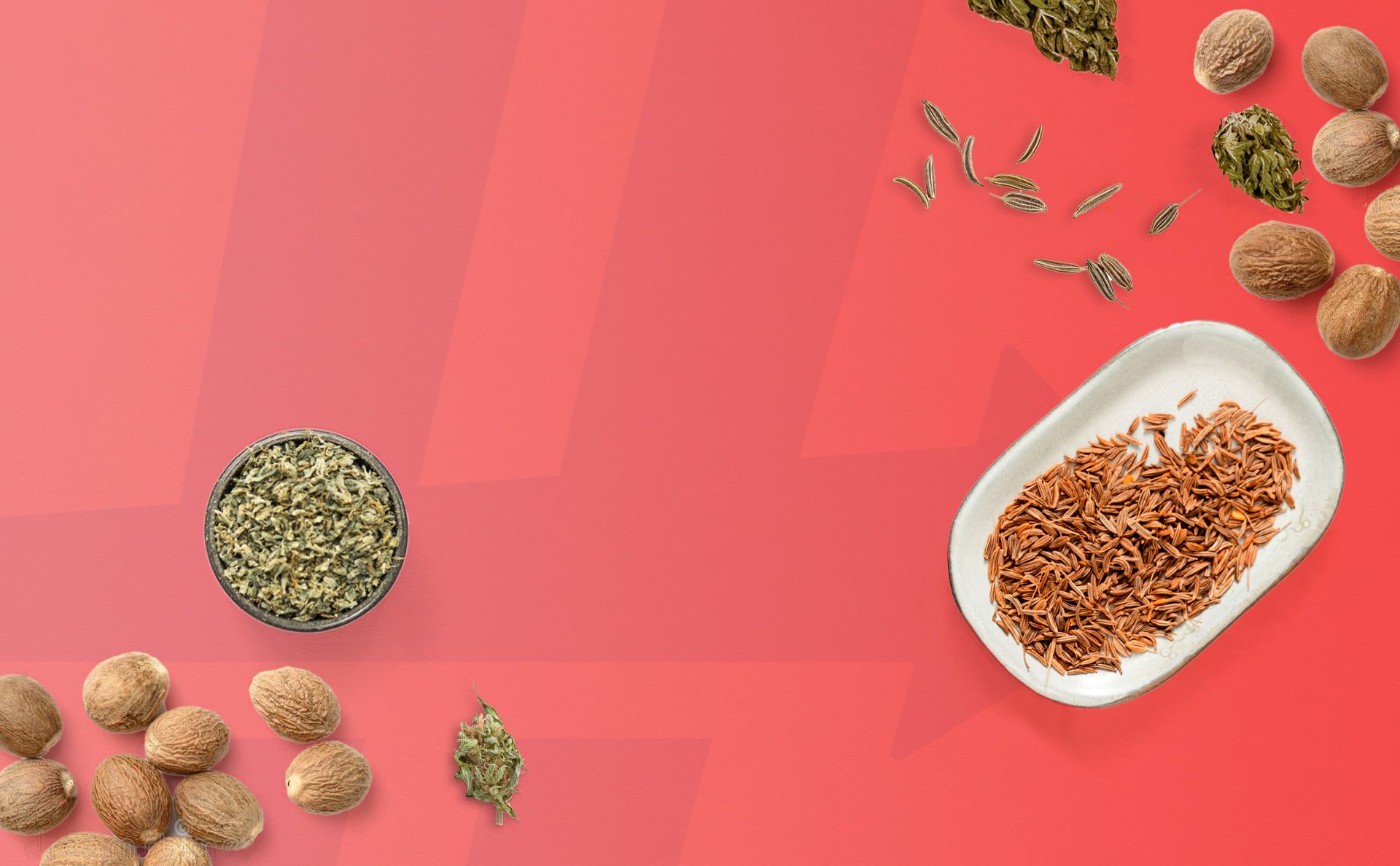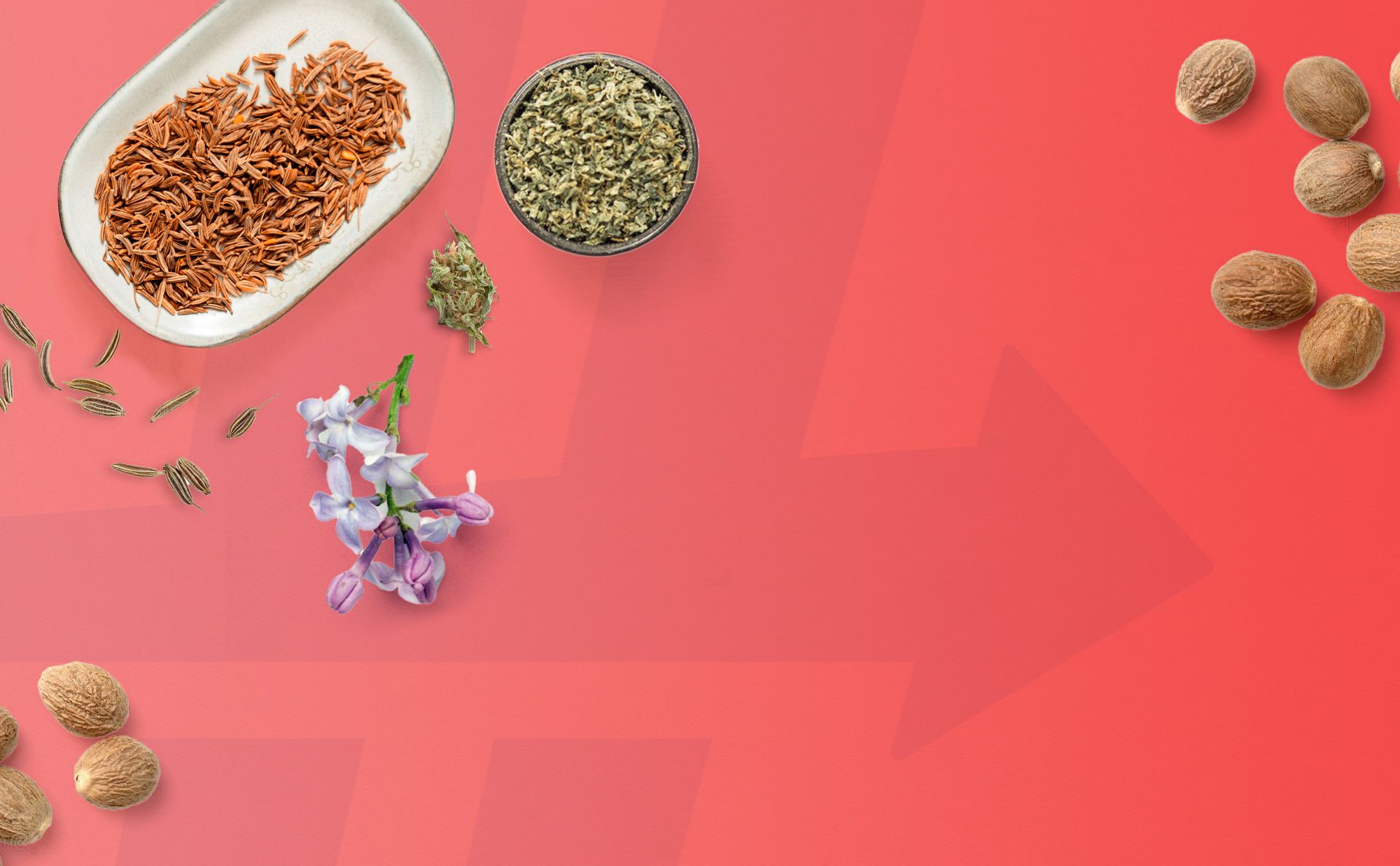Terpinolene
This chapter of our terpenes guide covers the complex compound called terpinolene. Discussed here are its taste and smell, and if terpinolene has any benefits.

What is Terpinolene? In this chapter, we discuss the flavor, aroma, and potential benefits of this complex and complicated terpene.
What is Terpinolene?
Pronounced “terp-in-oh-leen,” terpinolene is of the more complex and difficult to understand terpenes. Terpinolene is found in a wide variety of plants. You can find it in tea-tree, citrus fruits, navel oranges, apples, spices like nutmeg and cumin, as well as flowers like lilacs.
While more prominent terpenes like humulene, myrcene, and limonene are often found in abundance in many popular cannabis cultivars, terpinolene is less common and more variable in quantity between cultivars. Nevertheless, terpinolene is still considered one of the primary terpenes of cannabis.
Terpene Flavor and Aroma Profile: Terpinolene
Terpinolene’s uniquely complex flavors and aromas are an inviting mixture of earthy, piney, citrusy, herbaceous, and even a little floral. These flavors and aromas give depth to cultivars and to other food and plants that contain this unique terpene. The scent can basically be described, not so succinctly, as:
- Herbal
- Pine
- Citrus
- Floral
- Lilac

Unlike other cultivars that have a very specific flavor and taste like limonene, terpinolene is more complex and based on the individual cultivar. Terpinolene is perhaps the least common of the primary terpenes found in cannabis, usually found in only small amounts.

What the expert says...
Dr. Abraham Benavides
"Terpinolene is a flowery and fruity terpene found mostly in type I cannabis, more than types II or III. Few cultivars will be dominant in terpinolene, often co-occurring with myrcene or beta-caryophyllene, despite being labeled as “sativas” by retail."
Cultivars with the Terpene Terpinolene
Cultivars containing terpinolene are about as diverse as the terpene itself. Terpinolene isn't as prominent and rarely plays a leading role as do its relatives like myrcene and caryophyllene. However, you may recognize its presence in many of your favorite kinds of cannabis.
As we know currently, terpinolene mainly shows up in cultivars that are THC-dominant, and more commonly in what retail calls “sativa strains.” This means that few, high-CBD cultivars will feature terpinolene as its primary terpene.
Ironically, high terpinolene tends to occur with high levels of myrcene – a sedating terpene normally associated with “indica” cultivars. Despite this, retail still overrepresents high-terpinolene and myrcene cultivars as “sativa” products. This happens about twice as often as “indica strains”, revealing a scientific disconnect between retail and research. Some of the most popular cultivars containing terpinolene include:
- Dutch Treat
- Golden Pineapple
- Ghost Train Haze
- Orange Cookies
- J1
- Banana Blaze
- Lemon Kix
- Jack Herer
- Pandora’s box fresh
- Gipsy Haze
- Grapefruit OG
- Amnesia
- 10K Jack
- Critical Jack
- Sensi Star
In sum, terpinolene can be most appreciably found in type I (THC-dominant) cannabis. It can also be found to significantly lesser degrees in type II (1:1 THC:CBD), and type III cannabis, also called hemp (CBD-dominant).
Does Terpinolene Get You High?
Normally, we don't think of terpenes as being psychoactive. However, recent 2023 evidence shows us that certain terpenes like terpinolene may activate the CB1 receptor with at least 25% the strength of THC. Some of those terpenes, including terpinolene, even enhanced the CB1 response to THC, demonstrating that terpinolene may play a role in the entourage effect.
This means that terpinolene may have a subtle impact on the consumer when combined with other compounds in whole-plant cannabis, like cannabinoids and other terpenes. As is the case with so many other aspects of cannabis, more research is needed to determine this, and each consumer responds differently.
Potential Benefits of Terpinolene
According to the CannaKeys 360 research database, also medically reviewed by Dr. Benavides, the aggregated terpinolene data are strictly preclinical at this time. This means the little we know about its potential effects is only based on test tube and animal research. Terpinolene is also most often found with other terpenes at the same time, which may confound results.
Nevertheless, limited data show terpinolene may act as a:
- Anxiolytic and sedative
- Anti-cancer effects in mice and cancer models of neuroblastoma, breast, cervical, leukemic, and melanoma cells
- Anti-bacterial effects on Bacillus subtilis, Staphylococcus aureus, Enterococcus faecalis, Propionibacterium, Listeria, and Escherichia coli
- Antiparasitic effects against protozoa, nematodes, cestodes, and monogenan parasites
- Antifungal effects on Candida albicans, Aspergillus niger, Saccharomyces cerevisiae, as well as the spores of Diplodia pinea
- Pain-reliever, possibly synergistic with NSAIDS
- Antioxidant and anti-inflammatory
- May be preventative against heart disease
- Wound-healing
Traditional remedies like garlic, high in terpinolene and other terpenes, are used for a variety of ailments from skin trauma, wounds, and snakebites to gastric problems, ulcers, and other digestive issues.
What We Learned: Terpinolene
As we continue to see cannabis research progress forward, we could see the known benefits of terpenes like terpinolene increase. Here’s what we learned about Terpinolene in this chapter:
- Terpinene is less abundant in cannabis than other terpenes in our guide.
- Terpinolene’s uniquely complex flavors and aromas are an inviting mixture of earthy, piney, citrusy, herbaceous, and even a little citrusy or floral.
- Terpinolene is found in tea-tree oil, citrus fruits like navel oranges, spices like nutmeg and cumin, apples, as well as flowers like lilacs.
- Some of the most popular cultivars containing terpinolene are mainly sativas and include Dutch Treat, Golden Pineapple, Ghost Train Haze, Orange Cookies, J1, and Jack Herer.
- Terpinolene may have antibacterial and antifungal qualities and smells great, which is why it is found in many soaps.
- Studies also show that terpinolene shares many of the benefits common to other terpenes including antianxiety, sedating, anticancer, and antiinflammatory effects, among others.
- Terpinolene may trigger CB1 by itself with 25% the strength of THC, and may increase the high from THC.
- Preliminary research also shows that terpinolene, in conjunction with other terpenes as well as cannabinoids, may reduce the risk of heart disease.
The future is bright for the wonderful world of terpenes, and only time will tell how much more we can learn about these valuable natural compounds.
Only one more chapter to go to complete this guide! Well done. By now, you know the drill. See you in the next chapter.
Citations
- Al-Khazaleh, A. K., Zhou, X., Bhuyan, D. J., Münch, G. W., Al-Dalabeeh, E. A., Jaye, K., & Chang, D. (2024). The Neurotherapeutic Arsenal in Cannabis sativa: Insights into Anti-Neuroinflammatory and Neuroprotective Activity and Potential Entourage Effectshttps://doi.org/10.3390/molecules29020410
- Aydin, E., Türkez, H., & Taşdemir, S. (2013). Anticancer and antioxidant properties of terpinolene in rat brain cells. Arhiv Za Higijenu Rada I Toksikologiju, 64(3), 415–424.https://doi.org/10.2478/10004-1254-64-2013-2365
- Benavides, A. (2022, June 29). Terpinolene—Terpenes and Cannabinoid Research. Cannakeys.https://cannakeys.com/terpinolene-terpene-research/
- Chacon, F. T., Raup-Konsavage, W. M., Vrana, K. E., & Kellogg, J. J. (2022). Secondary Terpenes in Cannabis sativa L.: Synthesis and Synergy. Biomedicines, 10(12), 3142.https://doi.org/10.3390/biomedicines10123142
- Cox-Georgian, D., Ramadoss, N., Dona, C., & Basu, C. (2019). Therapeutic and Medicinal Uses of Terpenes. Medicinal Plants, 333–359.https://doi.org/10.1007/978-3-030-31269-5_15
- de Christo Scherer, M. M., Marques, F. M., Figueira, M. M., Peisino, M. C. O., Schmitt, E. F. P., Kondratyuk, T. P., Endringer, D. C., Scherer, R., & Fronza, M. (2019). Wound healing activity of terpinolene and α-phellandrene by attenuating inflammation ahttps://doi.org/10.1016/j.jtv.2019.02.003
- Grassmann, J., Hippeli, S., Spitzenberger, R., & Elstner, E. F. (2005). The monoterpene terpinolene from the oil of Pinus mugo L. in concert with alpha-tocopherol and beta-carotene effectively prevents oxidation of LDL. Phytomedicine: International Journahttps://doi.org/10.1016/j.phymed.2003.10.005
- Hanuš, L. O., & Hod, Y. (2020). Terpenes/Terpenoids in Cannabis: Are They Important? Medical Cannabis and Cannabinoids, 3(1), 25–60.https://doi.org/10.1159/000509733
- Lam, N. S., Long, X., Su, X., & Lu, F. (2020). Melaleuca alternifolia (tea tree) oil and its monoterpene constituents in treating protozoan and helminthic infections. Biomedicine & Pharmacotherapy, 130, 110624.https://doi.org/10.1016/j.biopha.2020.110624
- Liktor-Busa, E., Keresztes, A., LaVigne, J., Streicher, J. M., & Largent-Milnes, T. M. (2021). Analgesic Potential of Terpenes Derived from Cannabis sativa. Pharmacological Reviews, 73(4), 1269–1297.https://doi.org/10.1124/pharmrev.120.000046
- Macedo, E. M. A., Santos, W. C., Sousa, B. P., Lopes, E. M., Piauilino, C. A., Cunha, F. V. M., Sousa, D. P., Oliveira, F. A., & Almeida, F. R. C. (2016). Association of terpinolene and diclofenac presents antinociceptive and anti-inflammatory synergistichttps://doi.org/10.1590/1414-431X20165103
- Masyita, A., Mustika Sari, R., Dwi Astuti, A., Yasir, B., Rahma Rumata, N., Emran, T. B., Nainu, F., & Simal-Gandara, J. (2022). Terpenes and terpenoids as main bioactive compounds of essential oils, their roles in human health and potential application ahttps://doi.org/10.1016/j.fochx.2022.100217
- Oswald, I. W. H., Ojeda, M. A., Pobanz, R. J., Koby, K. A., Buchanan, A. J., Del Rosso, J., Guzman, M. A., & Martin, T. J. (2021). Identification of a New Family of Prenylated Volatile Sulfur Compounds in Cannabis Revealed by Comprehensive Two-Dimensionalhttps://doi.org/10.1021/acsomega.1c04196
- Smith, C. J., Vergara, D., Keegan, B., & Jikomes, N. (2021). The Phytochemical Diversity of Commercial Cannabis in the United States (p. 2021.07.05.451212). bioRxiv.https://doi.org/10.1101/2021.07.05.451212
- Sommano, S. R., Chittasupho, C., Ruksiriwanich, W., & Jantrawut, P. (2020). The Cannabis Terpenes. Molecules, 25(24), 5792.https://doi.org/10.3390/molecules25245792
Test your knowledge, track your progress and earn your badge.
Terpinolene mainly shows up in cultivars that are dominant in what cannabinoid?

Dr. Abraham Benavides
Dr. Abraham Benavides is an internationally-recognized cannabis research expert, experienced medical advisor, and full-tuition merit scholar of the George Washington University School of Medicine and Health Sciences. Dr. Abe enjoys helping patients as a writer, educator, and cannabis health coach at the GW Center for Integrative Medicine.